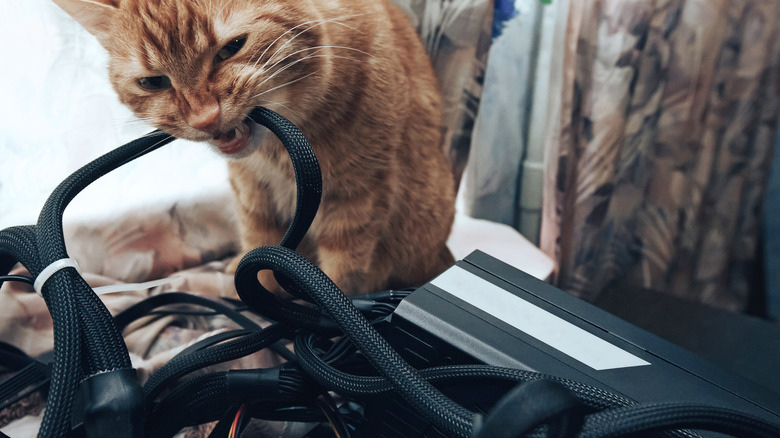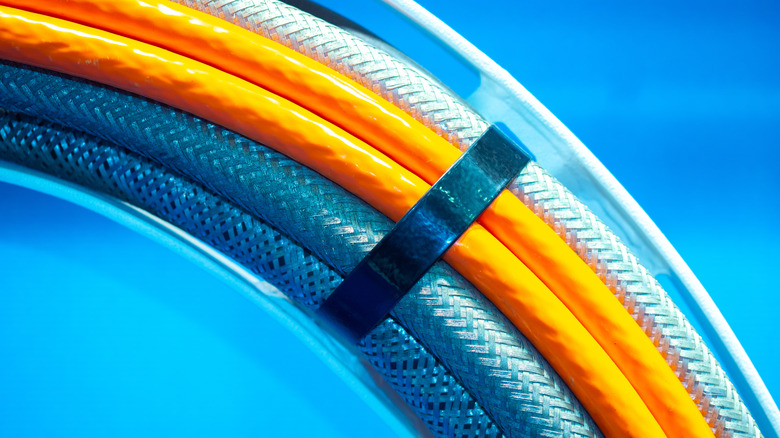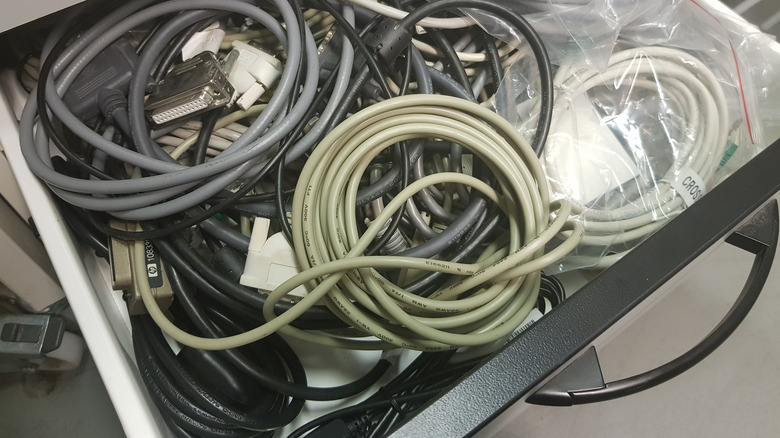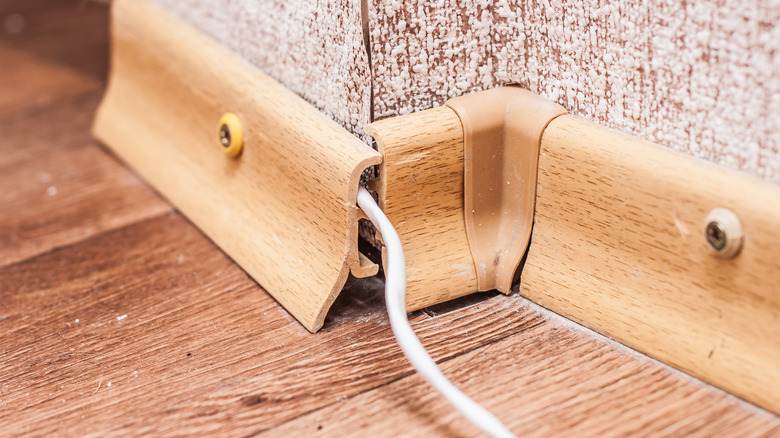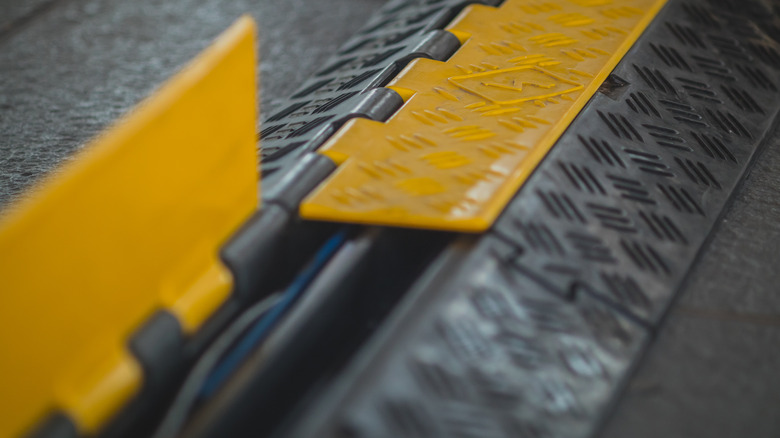5 Simple Ways To Hide Your TV Wires For A Cleaner Look
Does your connection spot look like a wire junk depot? The truth is, almost everyone has had to deal with arranging lots of wires every now and then. The problem with tangled-up wires is that sometimes they may cause home accidents and reduce the lifespan of your wires (via Shop Texas Electricity), and other times, it's quite difficult getting the right cable for the TV or other appliances without having to try several wires. Left alone, it's an eyesore; untangling them every two days is tasking, and it is quite impossible to resign to living in your home without an electrical connection at all — for foregoing all the cords isn't possible.
There are some different ways to keep these wires out of your view permanently — and keep them organized. Before jumping on these tips, it's important to follow safety measures. Since you'll be working with wires, you need to disconnect all cables from their sources before moving on, writes Popular Mechanics. Also, if you'll be opting for running wires on the wall, then you have to ensure the amperage level is suitable for the new connection, says ESB Networks. The good news here is that you can get your wires well-organized using common home tools without spending a fortune.
Organize with cable ties
One of the most affordable options to clear up the bundle of wires in your space is by organizing them by using cable ties. These are plastic or metal ties used to clip wires together without making them too tight to move around (via Engineering 360). Aside from cable ties being very affordable, they are also easy to maintain and keep your cables from damage, says Essentra Components.
Most times, there may be some wires just ruffled up in the mix without an actual connection. They may be old wires, some damaged, that you've probably forgotten to throw away. By using these cable ties, you'll fish them out and remove them, leaving only the useful ones. Interestingly, these cable ties come in different lengths, sizes, and colors. So, they come in handy regardless of your cable sizes and can be used for other purposes around the home.
While strapping these wires together, you can make the identification process easier by using different cable tie colors or adding small tags, writes M.M. Newman Corporation. According to Simply Spaced, labeling your tags helps transform your messy cable collection into a colorful and organized area. To keep them hidden, you can also pass them through your furniture set. With this, they won't be evident in your space again.
Store cables in drawers
Another way to utilize things already in your home to keep cable wires from hanging unorganized in your space is by keeping them in a drawer (via The Homes I Have Made). You probably have a small desk close to your TV area with a junk drawer. It's time to trash the junk and get the drawer to maximum use by storing your cables in them. Not to worry, you can easily create an outlet for the wires at the back of the drawer for easy connection, much like HGTV did with this floating shelf. Using a power drill, gently thrust through the center of the drawer at the back, then attach a power strip to the wall for direct connection.
For those spare, unused wires that you're not ready to let go of yet, you can showcase your DIY talent skills by creating a wire station using cardboard or wine boxes. By using this, you're contributing to the recycling process, and it also serves as a solution for people who don't have any spare junk drawers. If you have wine boxes in your home, bring them out and creatively form compartments for your wires. To secure the unused wires, try using empty toilet paper or paper towel rolls and place them in the box (via DIY Photography).
Keep wires in baseboard covers
Baseboards come in handy for keeping wires hidden as well. You can decide to run wires under the baseboards and window trims in an almost invisible way. If they are quite obvious, paint them with matching colors, and they become hidden from your visitors (via CableOrganizer)
You can also buy baseboard covers and attach them to the lower part of the board to create a channel for your wires. These covers are designed to resemble the actual baseboards and are easy to install. These covers are self-adhesive, so you need not worry about buying an adhesive. To attach, peel off the layer covering the adhesive part and firmly stick it to the wall. After that, you can insert and connect your wires through the openings. The best part of using these baseboard covers is that they are paintable and impact-resistant. Now you can enjoy your TV view without having to arrange wires all the time.
Hide wires in a cord cover
Cord covers are mostly made from plastic materials and attached to the wall to allow a smooth passage of wires to the wall without physical appearance (via Maker Stations). Cord covers are mostly preferred by many homeowners because they are affordable and somewhat stylish with a plethora of different colors available, says Shop Texas Electricity. So, if you're concerned about your cord covers looking odd in the space, simply work with your home color or paint them.
While you can hire a professional to help attach the cord covers, you can also try out this DIY trick. First, after buying your cord covers, measure the length of your wires and cut the covers to this length, writes Express Electrical Services experts. Stick the covers gently to your wall by applying adhesives to the surface. Ensure they align well and run through the needed space. Through the designed opening on the cover cords, insert your wires and plug them into the socket. That's it, you're all done perfectly hiding your wires.
Run wires inside walls
While all other methods we have mentioned help keep your wires organized and are pretty effective, they demand conscious efforts to retain them long-term. You could always explore the option of running the wires inside the walls (via The Home Theater DIY). In a nutshell, running the wires in the wall will keep the long ones secured, leaving a shorter length out for connection.
As we mentioned earlier, safety first — so turn off the power to avoid any accidents. Then, with a stud finder, try to locate free areas in the selected wall space to ensure you're not damaging ductwork or crossbeams, says Mister Sparky. Alternatively, you can use magnets to locate the ducts in the wall via K&J Magnetics. Once you've found your treasure spot, then cut out the free wall area with a utility knife and fish your wires in the installed cable plates. It's advisable to do this while it is very bright to avoid mistakes and make the final product look tidy. You'll also need to fill the wall back in and do some paint or wallpaper touch-up.
